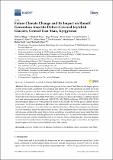Files in this item
Future climate change and its impact on runoff generation from the debris-covered Inylchek glaciers, central Tian Shan, Kyrgyzstan
Item metadata
| dc.contributor.author | Hagg, Wilfried | |
| dc.contributor.author | Mayr, Elisabeth | |
| dc.contributor.author | Mannig, Birgit | |
| dc.contributor.author | Reyers, Mark | |
| dc.contributor.author | Schubert, David | |
| dc.contributor.author | Pinto, Joaquim G. | |
| dc.contributor.author | Peters, Juliane | |
| dc.contributor.author | Pieczonka, Tino | |
| dc.contributor.author | Juen, Martin | |
| dc.contributor.author | Bolch, Tobias | |
| dc.contributor.author | Paeth, Heiko | |
| dc.contributor.author | Mayer, Christoph | |
| dc.date.accessioned | 2019-03-13T12:30:10Z | |
| dc.date.available | 2019-03-13T12:30:10Z | |
| dc.date.issued | 2018-10-25 | |
| dc.identifier | 258135209 | |
| dc.identifier | 775933fb-eabc-4d66-8ead-a260c6c960f1 | |
| dc.identifier | 85055468325 | |
| dc.identifier.citation | Hagg , W , Mayr , E , Mannig , B , Reyers , M , Schubert , D , Pinto , J G , Peters , J , Pieczonka , T , Juen , M , Bolch , T , Paeth , H & Mayer , C 2018 , ' Future climate change and its impact on runoff generation from the debris-covered Inylchek glaciers, central Tian Shan, Kyrgyzstan ' , Water , vol. 10 , no. 11 , 1513 . https://doi.org/10.3390/w10111513 | en |
| dc.identifier.other | ORCID: /0000-0002-8201-5059/work/55379122 | |
| dc.identifier.uri | https://hdl.handle.net/10023/17266 | |
| dc.description.abstract | The heavily debris-covered Inylchek glaciers in the central Tian Shan are the largest glacier system in the Tarim catchment. It is assumed that almost 50% of the discharge of Tarim River are provided by glaciers. For this reason, climatic changes, and thus changes in glacier mass balance and glacier discharge are of high impact for the whole region. In this study, a conceptual hydrological model able to incorporate discharge from debris-covered glacier areas is presented. To simulate glacier melt and subsequent runoff in the past (1970/1971-1999/2000) and future (2070/2071-2099/2100), meteorological input data were generated based on ECHAM5/MPI-OM1 global climate model projections. The hydrological model HBV-LMU was calibrated by an automatic calibration algorithm using runoff and snow cover information as objective functions. Manual fine-tuning was performed to avoid unrealistic results for glacier mass balance. The simulations show that annual runoff sums will increase significantly under future climate conditions. A sensitivity analysis revealed that total runoff does not decrease until the glacier area is reduced by 43%. Ice melt is the major runoff source in the recent past, and its contribution will even increase in the coming decades. Seasonal changes reveal a trend towards enhanced melt in spring, but a change from a glacial-nival to a nival-pluvial runoff regime will not be reached until the end of this century. | |
| dc.format.extent | 2716539 | |
| dc.language.iso | eng | |
| dc.relation.ispartof | Water | en |
| dc.subject | Climate scenarios | en |
| dc.subject | Debris-covered glaciers | en |
| dc.subject | Glaciers | en |
| dc.subject | Hydrological modelling | en |
| dc.subject | Tian Shan | en |
| dc.subject | Biochemistry | en |
| dc.subject | Geography, Planning and Development | en |
| dc.subject | Aquatic Science | en |
| dc.subject | Water Science and Technology | en |
| dc.subject | 3rd-DAS | en |
| dc.subject | SDG 13 - Climate Action | en |
| dc.subject | MCP | en |
| dc.title | Future climate change and its impact on runoff generation from the debris-covered Inylchek glaciers, central Tian Shan, Kyrgyzstan | en |
| dc.type | Journal article | en |
| dc.contributor.institution | University of St Andrews. School of Geography & Sustainable Development | en |
| dc.contributor.institution | University of St Andrews. Bell-Edwards Geographic Data Institute | en |
| dc.identifier.doi | 10.3390/w10111513 | |
| dc.description.status | Peer reviewed | en |
This item appears in the following Collection(s)
Items in the St Andrews Research Repository are protected by copyright, with all rights reserved, unless otherwise indicated.

